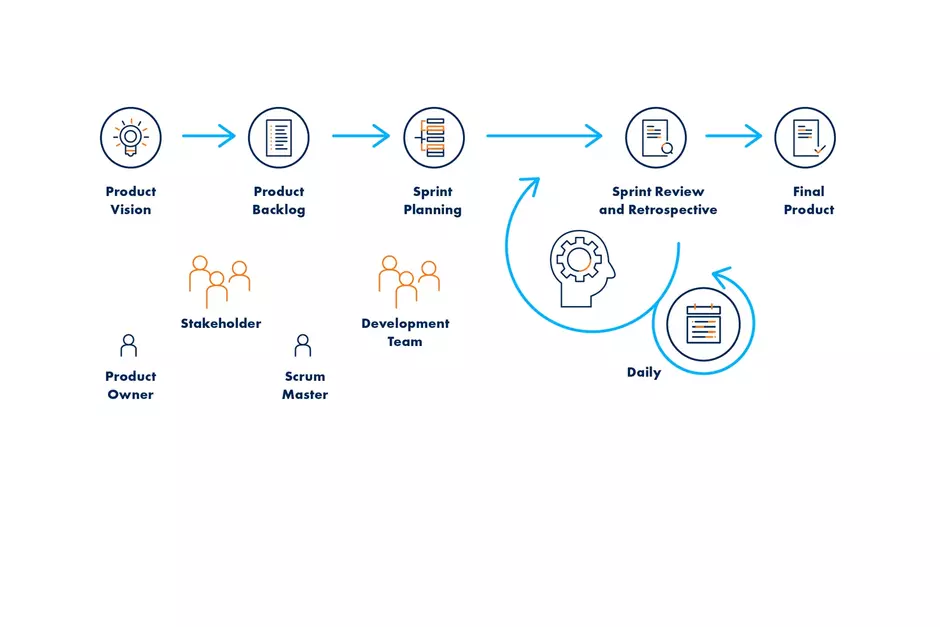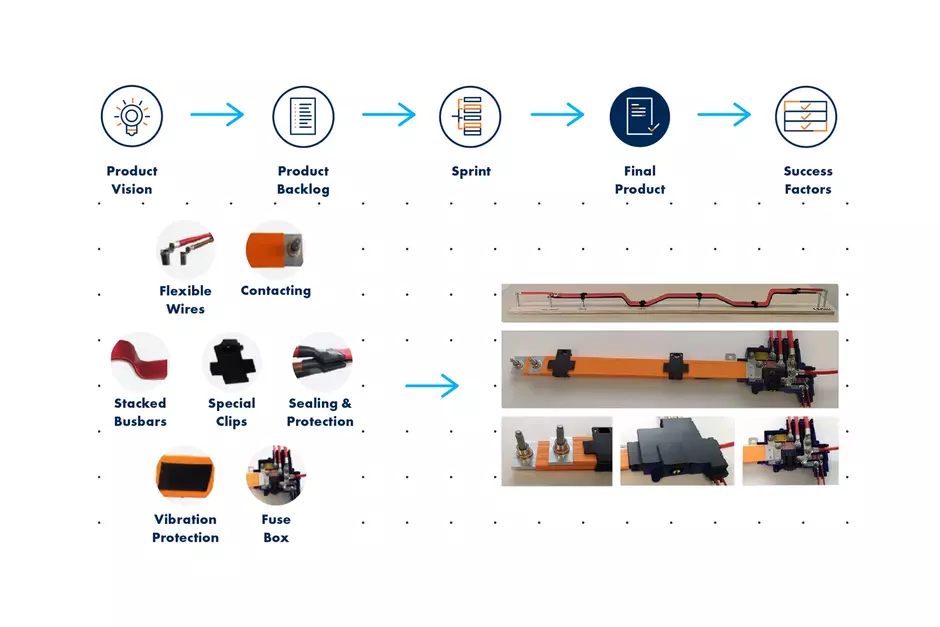A lot of companies are throwing out the phrase “agile methods” recently in public discussions to suggest modernity and progress. At LEONI, we’ve done more than just talk about it. We started introducing agile methods and work practices as part of our restructuring in 2021, and these are already producing demonstrable benefits.
For us, agility is more than just a toolbox – it’s a set of methods and the corresponding mindset.
We have carried out more than 24 development projects to date. Although we can’t yet provide scientifically valid data on the benefits of agile methods and procedures at LEONI, our development teams are clear in their assessment of the results produced by these methods: better communication and teamwork, greater flexibility, and even more fun at work.
What does agile working look like at Leoni?
Everything starts with the product vision, which is developed and refined by the product owner together with the stakeholders, i.e., internal and external customers. From the outset, the Scrum Master promotes agile principles in the LEONI concept and acts as a pace-setter.
As soon as the product vision has been established, the product owner prepares the “product backlog,” which contains all the work packages that need to be processed and contribute to the product vision. Once again, the product owner is in close contact with the customer and the development team.
After clarifying the “what”, the development team gets down to implementation; in other words, exactly “how” the product vision is then transformed into a real product.
An agile method requires working in sprints. To ensure that we always meet eye-to-eye during a sprint, the teams consult with each other daily or several times a week and clarify in a few minutes what they have been working on recently, what they will continue with, and where problems may need to be solved. The sprints are concluded with a Sprint Review and a Retrospective. In the Sprint Review, all stakeholders are invited to review the result and provide direct feedback. In the Retrospective, the development team reflects together on what went well and what went poorly in the last sprint in order to identify opportunities for improvement. The latter are usually implemented immediately.
The benefit of this approach is obvious: in a rapidly changing market with constantly changing requirements, this approach allows us to react quickly to changes and make prompt adjustments, always in cooperation with the customer. Instead of just discussing problems, the agile method requires a solution-oriented and open mindset with a willingness to learn.
Achieving a final product in just seven sprints
As an example, we used agile methods to complete the development of an energy backbone using stacked busbars for power distribution in vehicles within just six months. With conventional development methods, this leading-edge technology development would certainly have taken longer than a year.
In the first sprint, we collected requirements and evaluated the state of the art. The technologies required for the vision were then analyzed and evaluated in terms of application.
In the fourth sprint, we developed generic concepts using a morphological box. For these concepts, we created 3D models, performed electro-thermal and mechanical simulations, prepared production concepts, and produced cost evaluations. After only seven sprints, we had the final product physically “on the table” in form of several different prototypes.
What are the success factors?
One of the success factors is to have the CTO develop an internal agility concept. From the very outset, we understood that agility is far more than just a toolbox of methods.
A mindset that is focused on solutions and willing to learn is the fundamental precondition for a “truly” agile organization. To promote both the methods and the mindset, we developed a toolkit consisting of various elements. This toolkit contains the basics for agile projects (e.g., Scrum, Kanban) as well as an agile organization (e.g., processes, Portfolio Kanban), and is equipped with specific templates relevant to LEONI.
At the beginning, we repeatedly examined how to best embed know-how within the organization. We also considered training formats, and as an example, we developed a Scrum simulation using the example of a battery charging box. Employees can use this virtual case study to experience an agile project first-hand over a two-week period.
To minimize the trade-off between theory and practice, all the elements of the agile toolkit are closely based on real LEONI case studies. We also established cross-functional formats, such as the Agile Community of Practice and the Agility Council, that go beyond the area of development.
Knowledge of the potentials and limitations of agile methods is equally important. For example, we have learned that they provide benefits beyond the software development environment for which they were originally developed. We have successfully used agile methods in the development of hardware components as well.
Another thing we learned in our pilot phase – based upon two cancelled agile projects – was that the initial product vision must not be too broad or too open-ended. These experiences prompted us to develop a catalog of criteria for determining whether agile methods would make sense for specific projects.
None of this would have been possible if the CTO leadership team had not itself been so supportive of the rollout and open to new experiences on a daily basis. This factor has also been decisive for the implementation and success of this approach.
After the agile projects carried out so far, we at LEONI already have a steep learning curve behind us – but we are still far from the end. There is ongoing progress in all areas and we are constantly working on becoming better and more innovative every day. The fact that we are on the right track with our comprehensive approach is evident from the internal feedback and the reactions of our customers. They perceive the progress at LEONI very positively, especially when they are also internally implementing agile processes and methods themselves.
Do you have a question?
We’ll be glad to help. We look forward to hearing from you.
Marcel Ott
Head of Agile Management & Coaching





